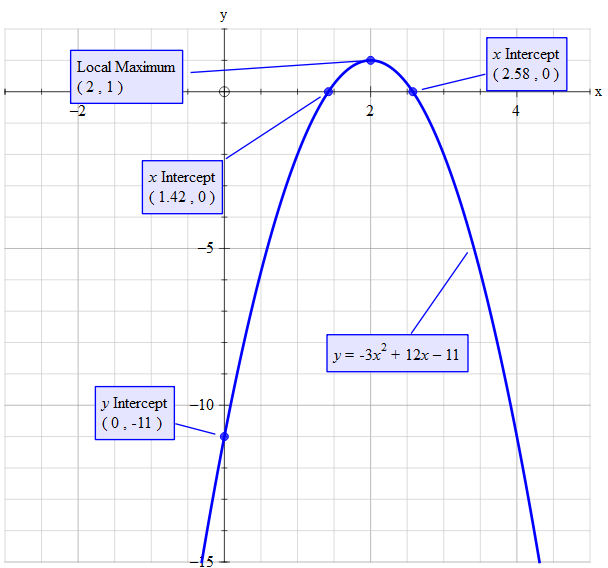Write as #y=-3x^2+12x-11#
Compare to the standardised form of #y=ax^2+bx+c#
~~~~~~~~~~~~~~~~~~~~~~~~~~~~~~~~~~~~~~~~~~~
#color(blue)("Determining the y-intercept")#
The y-intercept can and may be read off directly from the equation.
#->y=c#
#color(green)(=>y_("intercept")=-11)#
~~~~~~~~~~~~~~~~~~~~~~~~~~~~~~~~~~~~~~~~~~~~~~~~
#color(blue)("Determining the general shape of the curve")#
As #-3x^2# is negative the general shape of the #color(green)("curve is "nn)#
#color(green)("Thus the vertex is a maximum")#
~~~~~~~~~~~~~~~~~~~~~~~~~~~~~~~~~~~~~~~~~~~~~
#color(blue)("Determining the vertex")#
As the general shape is #nn# and the vertex is above the x-axis then x-intercepts exist.
As the other solution uses the formula I will use the vertex form (completing the square).
Given: #y=-3x^2+12x-11#
#y=ax^2+bx+c_1" " ->" " y=a(x+b/(2a))^2+c_2#
Write as#" "y=-3(x^2-12/6)^2+k-11#
Set#" "k+[a(b/(2a))^2]=0#
This 'gets rid' of the error completing the square introduces
#" "k+[-3(-12/(6))^2]=0#
#k-12=0" "=>" "k=+12#
#" "y=-3(x^2-12/6)^2+k-11#
#y=-3(x-2)^2+1#
#x_("vertex")=(-1)xx(b/(2a))^2 = (-1)xx(-2)=+2#
#y_("vertex")=+1#
#color(blue)("Vertex"->(x,y)=(2,1)#
~~~~~~~~~~~~~~~~~~~~~~~~~~~~~~~~~~~~~~
#color(blue)("Determine the x-intercepts")#
Set #y=-3(x-2)^2+1 = 0#
#(x-2)^2=1/3#
Take square roots of both sides
#x-2=+-sqrt(3)/3#
#x=2+-sqrt(3)/3#
#color(blue)(x=2+sqrt(3)/3 ~~2.58 )#to 2 decimal places
#color(blue)(x=2-sqrt(3)/3~~ 1.42)# to 2 decimal places



